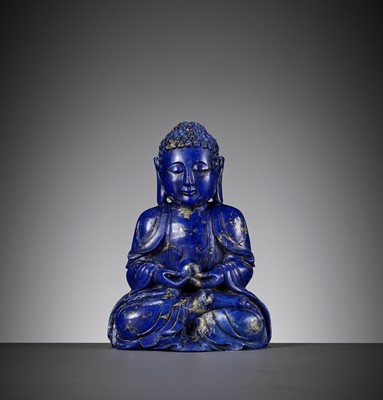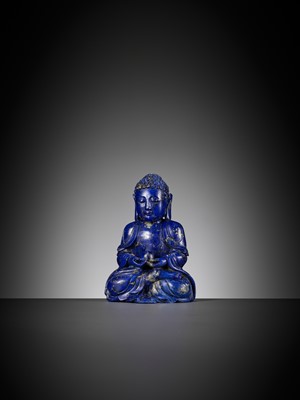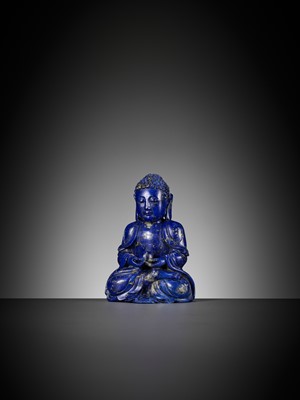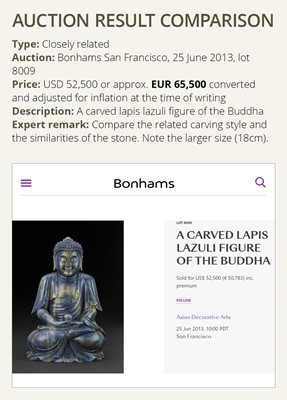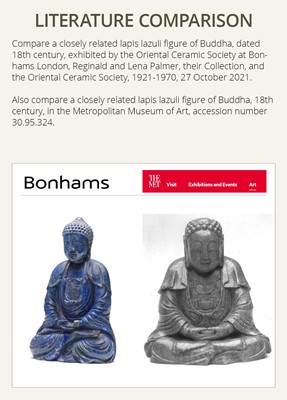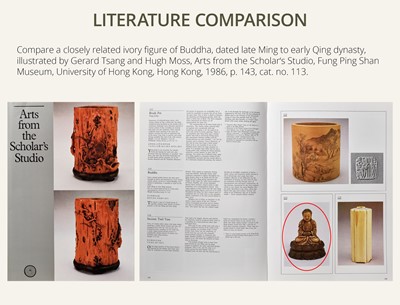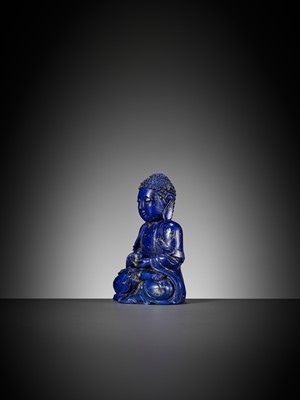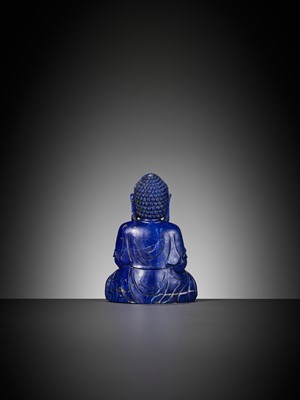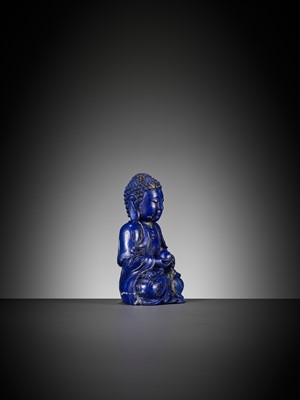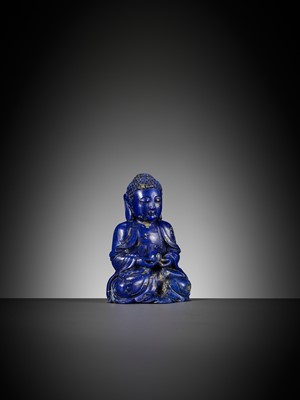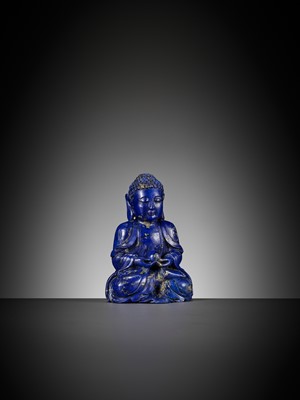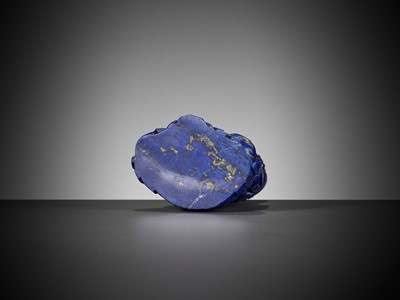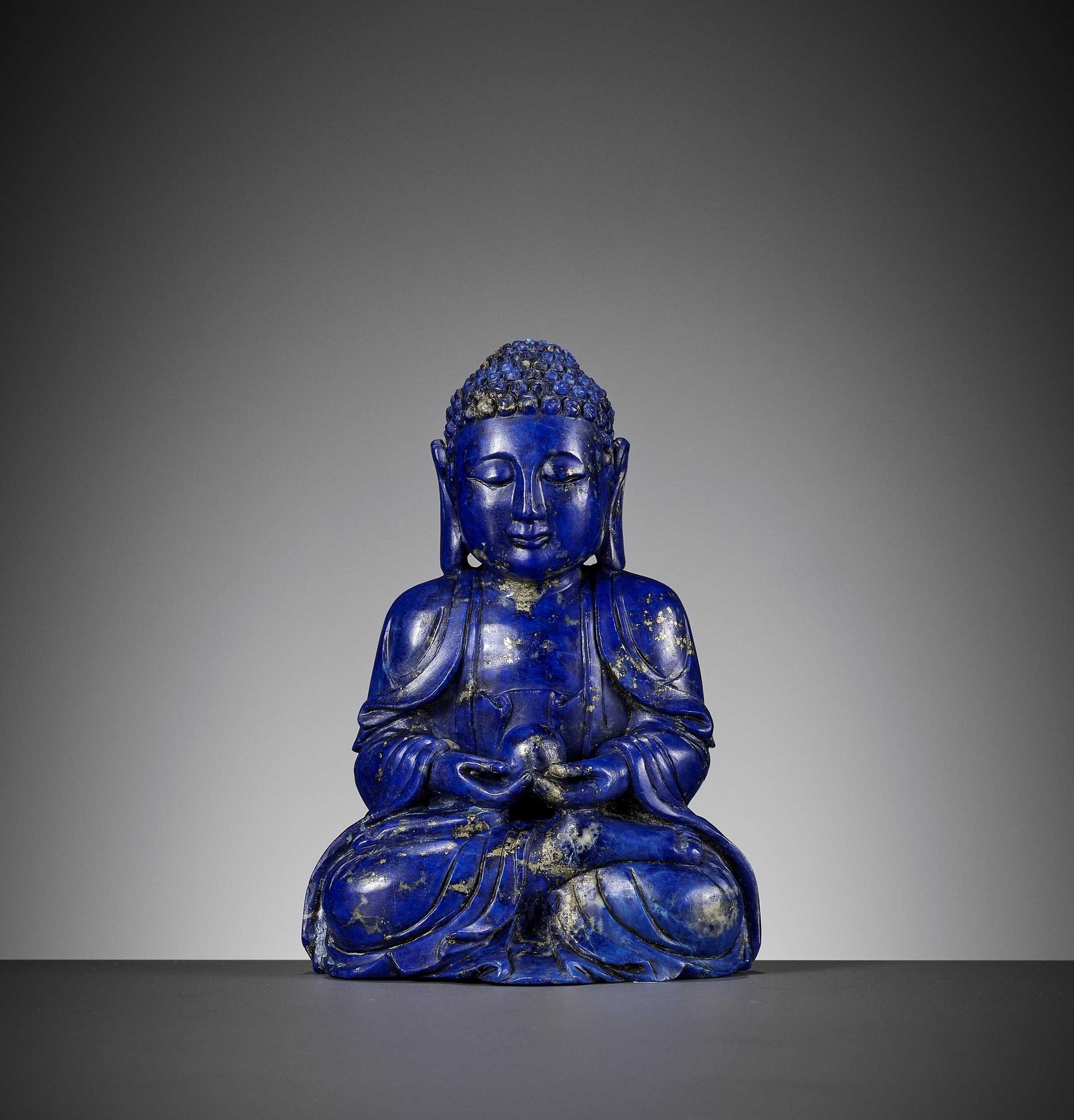29th Sep, 2022 13:00
DAY 1 - TWO-DAY AUCTION - Fine Chinese Art / 中國藝術集珍 / Buddhism & Hinduism
28
† A LAPIS LAZULI FIGURE OF BUDDHA, QING DYNASTY
清代青金石佛像
Sold for €5,005
including Buyer's Premium
China, mid-18th to 19th century. Superbly carved, seated in dhyanasana with the hands lowered in dhyana mudra, supporting a globular jewel, wearing a loose-fitting robe falling down the body in naturalistic folds, the wide face bearing a contemplative and serene expression marked by heavy-lidded downcast eyes and framed by long pendulous earlobes and sharply carved curls of hair surrounding a small ushnisha. The stone of an intense, striking blue hue amid veins in various shades of gray beneath glimmering mica flecks.
Provenance: A private collection in New England, USA. A notable private collector in Kensington, London, United Kingdom, acquired from the above.
Condition: Excellent condition with minor old wear and possibly microscopic nicks here and there. The stone with natural inclusions and fissures, some of which may have developed into small hairline cracks over time.
Weight: 301.5 g
Dimensions: Height 10 cm
With a velvet-padded silk storage box. (2)
Lapis lazuli was highly prized during the Qianlong period, as evidenced by a pair of Qianlong period stone lions dyed to imitate the stone, included in the exhibition Tributes from Guangdong to the Qing Court, Hong Kong, 1987, cat. Nos. 71 and 72, and a Qianlong period lapis lazuli mountain in the Asian Art Museum of San Francisco, illustrated in Michael Knight, He Li and Terese Tse Bartholomew, Chinese Jades, San Francisco, 2007, plate 354. The stone was mostly imported from Afghanistan, and was used principally for carving vessels, figures in relatively small sizes and boulder or grotto carvings, often with solitary luohans. Little Buddha figures, such as the present lot, were often made for smaller Imperial altars during the late 18th century and onwards.
Literature comparison:
Examples of lapis lazuli figures of Buddha are illustrated in Buddhist Art from Rehol, Tibetan Buddhist Images and Ritual Objects from the Qing Dynasty Summer Palace at Chengde, Taipei, 1999, no.81; and by M. Knight, He Li and T. Tse Bartholomew, Chinese Jades, San Francisco, 2007, no. 327, dated to the 18th century. Compare a closely related lapis lazuli figure of Buddha, dated 18th century, exhibited by the Oriental Ceramic Society at Bonhams London, Reginald and Lena Palmer, their Collection, and the Oriental Ceramic Society, 1921-1970, 27 October 2021. Compare a closely related lapis lazuli figure of Buddha, 18th century, in the Metropolitan Museum of Art, accession number 30.95.324. Compare a closely related ivory figure of Buddha, dated late Ming to early Qing dynasty, illustrated by Gerard Tsang and Hugh Moss, Arts from the Scholar's Studio, Fung Ping Shan Museum, University of Hong Kong, Hong Kong, 1986, p. 143, cat. no. 113.
Auction result comparison:
Type: Closely related
Auction: Bonhams San Francisco, 25 June 2013, lot 8009
Price: USD 52,500 or approx. EUR 65,500 converted and adjusted for inflation at the time of writing
Description: A carved lapis lazuli figure of the Buddha
Expert remark: Compare the related carving style and the similarities of the stone. Note the larger size (18cm).
清代青金石佛像
中國,十八世紀中期至十九世紀。精雕細琢,阿彌陀佛結珈趺坐,雙手結印,托寳珠,身穿寬鬆長袍,紋理流暢,面容慈祥,雙眼微垂,長耳垂,螺髻。青金石閃爍的雲母斑點,深淺不一的灰色紋理,醒目的藍色。
來源:美國新英格蘭私人收藏;英國倫敦肯辛頓知名私人收藏,購於上述收藏。
品相:狀況極好,有輕微磨損,大面積微小劃痕。具有天然紋理和裂縫的石料,其中一些可能隨著時間的推移發展成細小的裂縫。
重量:301.5 克
尺寸:高10 厘米
天鵝絨内襯盒子。
青金石在乾隆時期備受推崇,乾隆時期曾有一對仿青金石石獅,見廣東向清廷貢品展覽(香港,1987年,目錄編號 71與 72),以及舊金山亞洲美術館館藏青金石山子,見 Michael Knight, He Li and Terese Tse Bartholomew,《Chinese Jades》,舊金山,2007年,插圖 354。石料大部分是來自阿富汗,主要用於雕刻器皿、尺寸相對較小的人物以及山子,還有羅漢與佛陀造像,例如現拍品,通常是在十八世紀後為皇家祭廟製作。
文獻比較:
青金石佛像的例子,見《清宮秘藏:承德避暑山莊藏傳佛教文物特展圖錄》, 台北,1999年,編號81;以及另一件十八世紀的例子,見M. Knight,He Li and T. Tse Bartholomew,《China Jades》,舊金山,2007年,插圖327。比較一件非常相近的十八世紀青金石佛像,由東方陶瓷學會展出於倫敦邦瀚斯〈Reginald and Lena Palmer,their Collection〉,見〈東方陶瓷學會1921-1970〉,2021年10月27日。比較一件非常相近的十八世紀青金石佛像,收藏於大都會藝術博物館,編號30.95.324。比較一件非常相近的明末清初象牙雕佛像,見Gerard Tsang and Hugh Moss,《Arts from the Scholar's Studio》,香港大學美術博物館,香港,1986年,頁143,圖錄編號113。
拍賣結果比較:
形制:非常相近
拍賣:舊金山邦瀚斯,2013年6月25日,lot 8009
價格:USD 52,500(相當於今日EUR 65,500)
描述:青金石佛像
專家評論:比較相近的雕刻風格和石質。請注意尺寸較大 (18厘米)。
China, mid-18th to 19th century. Superbly carved, seated in dhyanasana with the hands lowered in dhyana mudra, supporting a globular jewel, wearing a loose-fitting robe falling down the body in naturalistic folds, the wide face bearing a contemplative and serene expression marked by heavy-lidded downcast eyes and framed by long pendulous earlobes and sharply carved curls of hair surrounding a small ushnisha. The stone of an intense, striking blue hue amid veins in various shades of gray beneath glimmering mica flecks.
Provenance: A private collection in New England, USA. A notable private collector in Kensington, London, United Kingdom, acquired from the above.
Condition: Excellent condition with minor old wear and possibly microscopic nicks here and there. The stone with natural inclusions and fissures, some of which may have developed into small hairline cracks over time.
Weight: 301.5 g
Dimensions: Height 10 cm
With a velvet-padded silk storage box. (2)
Lapis lazuli was highly prized during the Qianlong period, as evidenced by a pair of Qianlong period stone lions dyed to imitate the stone, included in the exhibition Tributes from Guangdong to the Qing Court, Hong Kong, 1987, cat. Nos. 71 and 72, and a Qianlong period lapis lazuli mountain in the Asian Art Museum of San Francisco, illustrated in Michael Knight, He Li and Terese Tse Bartholomew, Chinese Jades, San Francisco, 2007, plate 354. The stone was mostly imported from Afghanistan, and was used principally for carving vessels, figures in relatively small sizes and boulder or grotto carvings, often with solitary luohans. Little Buddha figures, such as the present lot, were often made for smaller Imperial altars during the late 18th century and onwards.
Literature comparison:
Examples of lapis lazuli figures of Buddha are illustrated in Buddhist Art from Rehol, Tibetan Buddhist Images and Ritual Objects from the Qing Dynasty Summer Palace at Chengde, Taipei, 1999, no.81; and by M. Knight, He Li and T. Tse Bartholomew, Chinese Jades, San Francisco, 2007, no. 327, dated to the 18th century. Compare a closely related lapis lazuli figure of Buddha, dated 18th century, exhibited by the Oriental Ceramic Society at Bonhams London, Reginald and Lena Palmer, their Collection, and the Oriental Ceramic Society, 1921-1970, 27 October 2021. Compare a closely related lapis lazuli figure of Buddha, 18th century, in the Metropolitan Museum of Art, accession number 30.95.324. Compare a closely related ivory figure of Buddha, dated late Ming to early Qing dynasty, illustrated by Gerard Tsang and Hugh Moss, Arts from the Scholar's Studio, Fung Ping Shan Museum, University of Hong Kong, Hong Kong, 1986, p. 143, cat. no. 113.
Auction result comparison:
Type: Closely related
Auction: Bonhams San Francisco, 25 June 2013, lot 8009
Price: USD 52,500 or approx. EUR 65,500 converted and adjusted for inflation at the time of writing
Description: A carved lapis lazuli figure of the Buddha
Expert remark: Compare the related carving style and the similarities of the stone. Note the larger size (18cm).
清代青金石佛像
中國,十八世紀中期至十九世紀。精雕細琢,阿彌陀佛結珈趺坐,雙手結印,托寳珠,身穿寬鬆長袍,紋理流暢,面容慈祥,雙眼微垂,長耳垂,螺髻。青金石閃爍的雲母斑點,深淺不一的灰色紋理,醒目的藍色。
來源:美國新英格蘭私人收藏;英國倫敦肯辛頓知名私人收藏,購於上述收藏。
品相:狀況極好,有輕微磨損,大面積微小劃痕。具有天然紋理和裂縫的石料,其中一些可能隨著時間的推移發展成細小的裂縫。
重量:301.5 克
尺寸:高10 厘米
天鵝絨内襯盒子。
青金石在乾隆時期備受推崇,乾隆時期曾有一對仿青金石石獅,見廣東向清廷貢品展覽(香港,1987年,目錄編號 71與 72),以及舊金山亞洲美術館館藏青金石山子,見 Michael Knight, He Li and Terese Tse Bartholomew,《Chinese Jades》,舊金山,2007年,插圖 354。石料大部分是來自阿富汗,主要用於雕刻器皿、尺寸相對較小的人物以及山子,還有羅漢與佛陀造像,例如現拍品,通常是在十八世紀後為皇家祭廟製作。
文獻比較:
青金石佛像的例子,見《清宮秘藏:承德避暑山莊藏傳佛教文物特展圖錄》, 台北,1999年,編號81;以及另一件十八世紀的例子,見M. Knight,He Li and T. Tse Bartholomew,《China Jades》,舊金山,2007年,插圖327。比較一件非常相近的十八世紀青金石佛像,由東方陶瓷學會展出於倫敦邦瀚斯〈Reginald and Lena Palmer,their Collection〉,見〈東方陶瓷學會1921-1970〉,2021年10月27日。比較一件非常相近的十八世紀青金石佛像,收藏於大都會藝術博物館,編號30.95.324。比較一件非常相近的明末清初象牙雕佛像,見Gerard Tsang and Hugh Moss,《Arts from the Scholar's Studio》,香港大學美術博物館,香港,1986年,頁143,圖錄編號113。
拍賣結果比較:
形制:非常相近
拍賣:舊金山邦瀚斯,2013年6月25日,lot 8009
價格:USD 52,500(相當於今日EUR 65,500)
描述:青金石佛像
專家評論:比較相近的雕刻風格和石質。請注意尺寸較大 (18厘米)。
Zacke Live Online Bidding
Our online bidding platform makes it easier than ever to bid in our auctions! When you bid through our website, you can take advantage of our premium buyer's terms without incurring any additional online bidding surcharges.
To bid live online, you'll need to create an online account. Once your account is created and your identity is verified, you can register to bid in an auction up to 12 hours before the auction begins.
Intended Spend and Bid Limits
When you register to bid in an online auction, you will need to share your intended maximum spending budget for the auction. We will then review your intended spend and set a bid limit for you. Once you have pre-registered for a live online auction, you can see your intended spend and bid limit by going to 'Account Settings' and clicking on 'Live Bidding Registrations'.
Your bid limit will be the maximum amount you can bid during the auction. Your bid limit is for the hammer price and is not affected by the buyer’s premium and VAT. For example, if you have a bid limit of €1,000 and place two winning bids for €300 and €200, then you will only be able to bid €500 for the rest of the auction. If you try to place a bid that is higher than €500, you will not be able to do so.
Online Absentee and Telephone Bids
You can now leave absentee and telephone bids on our website!
Absentee Bidding
Once you've created an account and your identity is verified, you can leave your absentee bid directly on the lot page. We will contact you when your bids have been confirmed.
Telephone Bidding
Once you've created an account and your identity is verified, you can leave telephone bids online. We will contact you when your bids have been confirmed.
Classic Absentee and Telephone Bidding Form
You can still submit absentee and telephone bids by email or fax if you prefer. Simply fill out the Absentee Bidding/Telephone bidding form and return it to us by email at office@zacke.at or by fax at +43 (1) 532 04 52 20. You can download the PDF from our Upcoming Auctions page.
How-To Guides
How to Create Your Personal Zacke Account
How to Register to Bid on Zacke Live
How to Leave Absentee Bids Online
How to Leave Telephone Bids Online
中文版本的操作指南
创建新账号
注册Zacke Live在线直播竞拍(免平台费)
缺席投标和电话投标
Third-Party Bidding
We partner with best-in-class third-party partners to make it easy for you to bid online in the channel of your choice. Please note that if you bid with one of our third-party online partners, then there will be a live bidding surcharge on top of your final purchase price. You can find all of our fees here. Here's a full list of our third-party partners:
- 51 Bid Live
- EpaiLive
- ArtFoxLive
- Invaluable
- LiveAuctioneers
- the-saleroom
- lot-tissimo
- Drouot
Please note that we place different auctions on different platforms. For example, in general, we only place Chinese art auctions on 51 Bid Live.
Bidding in Person
You must register to bid in person and will be assigned a paddle at the auction. Please contact us at office@zacke.at or +43 (1) 532 04 52 for the latest local health and safety guidelines.
